
© HANNES GROBE/CC BY SA 3.0
24 |
Text by Jenny Day |
|---|---|
Lesser-known invertebrates

© HANNES GROBE/CC BY SA 3.0

© C. GRIFFITHS
Very primitive organisms. Body consists of aggregates of cells around a network of tiny channels and chambers lined by flagellated collar cells (‘choanocytes’, see Protista p.328, 4). The beating flagella generate a current, water entering and leaving the body through a series of surface pores. The current brings minute particles of organic matter, which are consumed by the collar cells lining the chambers. Freshwater sponges are mostly of indefinite shape and usually pale to brown in colour. The body is supported by a meshwork of protein called spongin and a ‘skeleton’ of minute siliceous spicules (1, spicule of a sponge) that differ from species to species. Very variable in shape even within a species, so spicules are important for identifying species. Vegetative reproduction by budding, even small fragments being able to grow and establish themselves. Adults also reproduce sexually, releasing sperm that are drawn into the body of another individual with the feeding currents. Fertilised eggs within the body form minute flagellated balls of cells that are expelled through a surface pore, settling onto a hard surface and growing into adult sponges. Some freshwater sponges produce numerous hard-shelled, desiccation-resistant reproductive bodies called gemmules (1a, gemmules under a cover of sponge cells), about 1mm across, which contain cells packed with food reserves and that are able to survive out of water for some months. About seven species of freshwater sponge have been recorded from southern Africa, only one from the Western Cape.
2 Freshwater sponge
Ephydatia fluviatilis


© TODD PAULSEN//CC BY SA 2.5
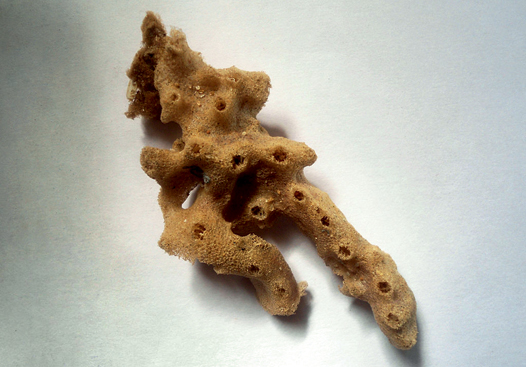
© ADITYAMADHAV83/CC BY SA 3.0

© C. GRIFFITHS
Flat sheets becoming bulbous with a corrugated surface (2a) as they grow. Fairly brittle; colour usually pale to brown. Size: Reach 20cm or more in diameter. Biology: Common on hard vertical faces, the undersides of boulders and on stems of emergent plants, often in temporary waters. Specimens may become bright green (2b) because of symbiotic Chlorella-like algal cells (p.314, 2). Other nearby sponges of the same species may remain pale in colour. From Cape Flats to Namibia and in temperate regions worldwide. RELATED SPECIES: At least four other species in the same family (Spongillidae) from further north in Africa.
3 African freshwater sponges
Family Potamolepidae


© W. UYS

© W. UYS
Encrusting sponges- with a rough bark-like surface and regularly distributed exhalent pores, often on projections. Size: Up to 10mm thick. Biology: This family, which contains the genera Potamolepis (3) and Potamophloios (3a), is endemic to tropical African rivers; very little is known about it, and no southern African potamolepids have yet been identified to species, which depends on features of the gemmules.

© M. PLEWKA

© G. MATTHEWS
Simple animals consisting of a hollow tubular or umbrella-shaped body with a row of tentacles at one end. All aquatic, mostly marine. Food in the form of small planktonic creatures (e.g. Daphnia, p.252, 5) is caught by stinging cells (1, part of a tentacle showing several stinging cells; 1a, stinging cells under high magnification; inset, close up of a single stinging cell) on the tentacles, which adhere to the prey. Tentacles then retract and pull the food into the mouth. Most marine cnidarians have both medusoid (jellyfish-like) and polypoid (hydra- or anemone-like) stages in their life cycles, but freshwater hydras have no medusoid stage, and the polyp stage of freshwater jellyfish is tiny and seldom encountered.
Hydras
Order Hydrida

© C. GRIFFITHS
Tubular, anemone-like predators attached to solid surfaces in unpolluted wetlands and slow-flowing streams. Commonly feed on cladocerans such as Daphnia (p.252, 5). When disturbed or killed, they retract, forming small featureless balls that are hard to recognise. Reproduction by budding (2), forming new individuals asexually. When conditions are unfavourable, ovaries and testes develop, on the same individual in some species. Resting eggs produced sexually can survive poor conditions for some time. Currently all species worldwide seem to be included in the single genus Hydra, but the taxonomy of African hydras needs to be revised.
3 Green hydra
Hydra viridissima


© M. PLEWKA
A typical hydra, but green because of the symbiotic zoochlorellae (related to Chlorella, p.314, 2) in its cells. Note the colourless nematocysts in the outer layer. Size: Body up to 10mm in length, tentacles up to 15mm. Biology: Green hydras have been recorded from different parts of southern Africa on a number of occasions. As yet, only a single species with green individuals has been described; previously known as Chlorhydra viridissima.
4 Brown hydra
Hydra oligactis

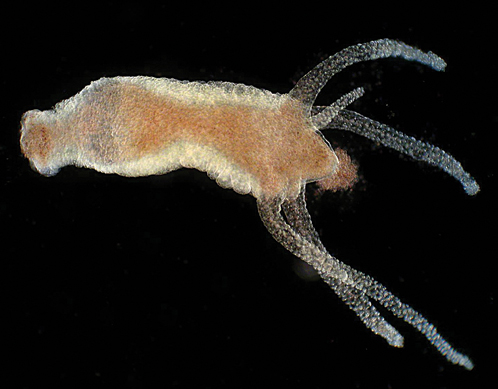
© M. PLEWKA
A typical hydra, but brownish or yellowish in colour, with no zoochlorellae in the cells. Budding individuals shown. Size: Up to 10mm in length, with tentacles up to 15mm when fully extended. Biology: Often found on submerged plants such as water lilies. Most of the hydras recorded from southern Africa are said to belong to this species.
Medusas (jellyfishes)
Order Limnomedusae
Freshwater jellyfishes, free-swimming in the plankton. Not commonly encountered, but when present can occur in blooms of millions of individuals. The animal consists of an umbrella-shaped body with a row of tentacles around the rim. Sexual reproduction occurs, and sexes are separate. Fertilised egg forms a minute larva called a planula, which settles to the bottom and buds to form a branching polyp colony, from which new medusae bud.
5 Common freshwater jellyfish
Craspedacusta sowerbii


© OPENCAGE/CC BY SA 2.5
Medusa bell-shaped, with 200–400 marginal tentacles in three sets (withdrawn in inset). Gut cavity slender, reaching margin of bell. Gonads sac-like (compare with Great Lakes jellyfish, 6 below). Size: 15–20mm in diameter. Biology: Most widespread of all freshwater jellyfishes, perhaps cosmopolitan but possibly introduced to southern Africa. Recorded from KwaZulu-Natal and the Western Cape in large lakes, reservoirs and small ponds; not known from temporary waters. RELATED SPECIES: Moerisia (= Ostroumovia) inkermanica is much smaller, (<10mm in diameter) and occurs in brackish coastal lakes.
6 Great Lakes jellyfish
Limnocnida tanganjicae


© SÉBASTIEN TRAPE
Medusa disc-shaped with about 300 marginal tentacles of different lengths. Gonads not in sacs (as in Common freshwater jellyfish, 5 above), but spread around the bell as a circle. Size: Up to 250mm in diameter. Biology: Apparently endemic to the lakes and reservoirs of tropical Africa, from the Limpopo River to the Rift Valley; one record from a fish pond in Johannesburg. Polyps found on stems of macrophytes.

© WATER/WASTEWATER DISTANCE LEARNING

© ED ZABORSKI
Small, stiff, wiry worms, completely round in cross section and surrounded by a tough inflexible cuticle that allows only limited writhing movements. Feed on microscopic particles or organically rich liquids. Reproduction is sexual: both males and females are found and fertilisation takes place by copulation. Most species are parasitic, some infesting plants and others animals. Several species cause serious diseases in humans. Microscopic free-living nematodes are also found in inland waters (1, 1a, unidentified species). Nematodes are generally very uniform in external appearance, and the features used in classification are difficult to see without a high-powered microscope, so they are hard to identify accurately. Most free-living freshwater species are tiny (<1mm in length), but a few reach lengths of 10cm or more. About 150 free-living species have been recorded from inland waters and associated muds in southern Africa. Larger parasitic forms live internally in fish and various invertebrates.
2 Mosquito-parasitising nematodes
Family Mermythidae


© BEENTREE/CC BY SA 3.0
Nematodes of this family parasitise and kill mosquito larvae and other insects. Size: About 5–10mm in length. Biology: Eggs can survive desiccation for months and could therefore be used in biological control of mosquitoes that live in temporary ponds.
3 Microfilarial roundworm larvae
Wucheraria bancrofti


© J. DAY
The larva of the nematode that causes elephantiasis in Africa. Microscope slide of stained human blood shown: pale pink discs are red blood cells; dark blobs are stained white blood cells; the larva is purple and pink. Size: 0.3mm. Biology: The larvae are transmitted by the bite of simuliid flies, whose larvae (p.214, 2) live in fast-running streams.

© ŠPAČEK
Primitive worms with soft, featureless, cylindrical bodies, two pairs of eyes and a slender proboscis (sometimes seen protruding from the anterior end as in 4) armed with a stylet. Reproduction sexual. Mostly marine.
5 Freshwater nemerteans
Prostoma species


© ŠPAČEK
The only genus known from southern African fresh waters. Size: Up to 20mm long. Biology: Tend to burrow, or to live under stones or in submerged vegetation in streams; not common and not (yet) found in wetlands. Food consists of small invertebrates caught by stabbing with the stylet. Females produce large numbers of yolky eggs that hatch as miniature adults. Under adverse conditions eggs secrete a protective layer of mucus that dries and resists desiccation. RELATED SPECIES: Both Prostoma graecense and P. eilhardi have been recorded from South Africa; species distinguishable only by histological sectioning or genetic analysis.
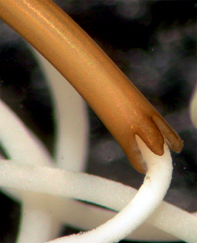
© B. HANELT, M.G. BROLEK, A. SCHMIDT-RHAESA/CC BY SA 2.5

© B. HANELT, M.G. BROLEK, A. SCHMIDT-RHAESA/CC BY SA 2.5

© ALAISTER RAE/CC BY SA 2.0
Long, wiry, pale to brown worms with no obvious surface features. Adults free-living, but larvae parasitise insects, mostly grasshoppers and other orthopterans. The life cycle is complex. Male and female worms copulate in water, often forming a tangled ‘gordian knot’. Fertilised eggs (6, posterior of a female laying a string of eggs) hatch into minute larvae (6a) that are eaten by small aquatic invertebrates such as chironomid larvae. The nematomorph larvae encyst in the body of the host and develop no further unless the host is eaten by a foraging cricket or locust, which becomes the next host. Parasitised orthopterans (6b) tend to fly to water, where they die, thus releasing the adult worms to complete their life cycles.
7 Horsehair worms
Paragordius species


© C. GRIFFITHS
Size: Adults 20–30cm in length. Biology: Quite commonly encountered in South Africa, often in swimming pools after emerging from a parasitised host. Species diversity in southern Africa not known, but Gordius and Paragordius probably occur in the region.
A small phylum of tiny invertebrates living in the plankton or near the bottom of wetlands and the sea. Body slightly elongate, often with rows of small spines protecting a layer of locomotory cilia. Body 0.1–3mm in length. Most attach by means of adhesive glands or glide over the surface by means of cilia. Food, in the form of small organic particles, is hoovered up by the muscular pharynx. Most species are parthenogenetic; no larvae are known. Some live in anaerobic muds and are resistant to poor water quality; eggs of others that live in temporary waters are resistant to desiccation. Several species known from southern Africa.
1 Gastrotrichs
Kijanebalola devestiva


© A. TODARO
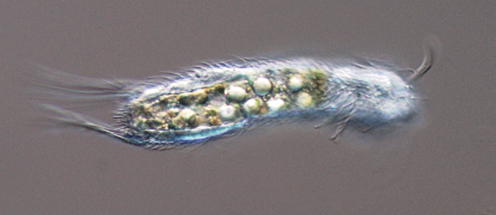
© A. TODARO

© C. KREBS
Body small with few spines. Size: Body length 0.3mm. Biology: Little known; species only recently described from a freshwater pond near Lake St Lucia, KwaZulu-Natal. RELATED SPECIES: Neogossea acanthocolla (body length 1mm) (1a) has a cuticle with rows of spines. Planktonic and parthenogenetic; some eggs remain inactive during long dry spells. Several undescribed species of Chaetonotus (1b) are known from southern Africa.

© R. SCHILLER
A small phylum of minute animals found in damp mosses and lichens, and also in small temporary wetlands, particularly in arid areas. Four pairs of legs, each ending in a complex claw. Some species live in hot springs, others on high mountains, others in ocean depths. Some have even survived unprotected after a few days in outer space! They survive extreme conditions by turning themselves into desiccation-resistant bags of cells known as ‘tuns’ (2, false colour image). Feed on small living cells by piercing them with a pair of sharp stylets protruding from the mouth. Reproduce parthenogenetically or sexually.
3 Tardigrade
Hypsibius species
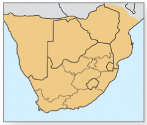

© C. KREBS
Size: Body length about 0.5mm. Biology: Many species have been described from Africa, but apparently none from inland waters in southern Africa, although some have been observed in casual microscopic investigation of temporary waters from the Namib and Kalahari deserts.
Very small invertebrates found throughout the world, mostly in fresh waters. Body elongate, with a crown of whirling cilia (thus ‘wheel animals’) anteriorly and usually two or three adhesive ‘toes’ posteriorly. The beating cilia produce a water current that brings small organic particles to the mouth. Some are planktonic, but most are benthic, attaching to the substrate by means of the ‘toes’, but able to detach and swim from place to place using the crown of cilia. The body may be elongate and retractile, or enclosed in a stiff chitinous cuticle called a 'lorica’. Some live in gelatinous tubes and some are colonial. The order Bdelloidea famously seems to have had no males for at least the last 80 million years. Unfertilised eggs may either hatch immediately, or diapause until favourable conditions occur. Adult bdelloids survive desiccation by drying out; in other groups the eggs are resistant to desiccation. Many species are probably cosmopolitan; the species illustrated here merely give an impression of rotifer diversity.
4 Box-like rotifers
Family Brachionidae


© L. BECKS
Brachionus calyciflorus is planktonic, unsegmented, with retractile foot; box-like in shape. Size: Body about 0.3mm in length. Biology: Cosmopolitan and known from large impoundments throughout the region. Feeds on large ciliates and flagellates. RELATED SPECIES: B. plicatilis known from saline ponds in the Kalahari.
5 Retractile rotifers
Family Philodinidae

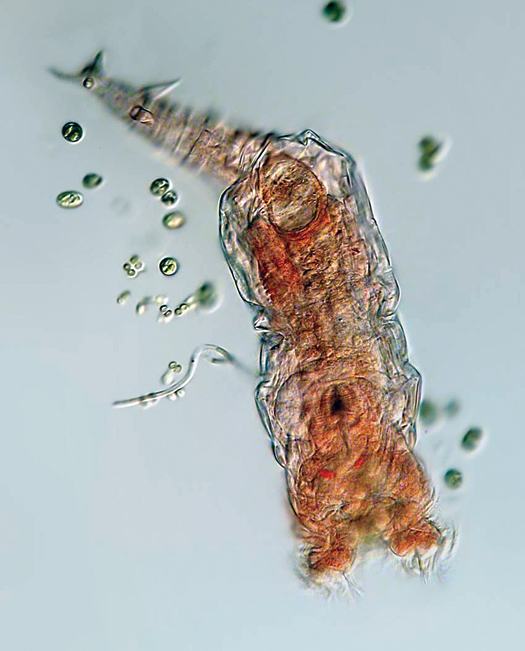
© M. PLEWKA
Philodina roseola is cylindrical, with a highly contractile body. Size: Approximately 0.5mm in length. Biology: Swims using the crown of cilia or attaches to the substrate by means of the toes. Parthenogenetic. Common in small ponds.
1 Sheathed rotifers
Family Flosculariidae


© M.J. FOX/CC BY SA 3.0
Conochilus unicornis is colonial, planktonic, encased in a gelatinous sheath. Colonies with up to 160 individuals and include adults and young. Size: Individuals 0.3–0.8mm in length. Biology: Sexual and asexual reproduction; cosmopolitan.
2 Jumping rotifers
Family Hexarthridae


© M. PLEWKA
Hexarthra jenkinae is short and squat with six muscular appendages that allow it to jerk about (hence common name). Size: Body 0.2mm in length. Biology: Usually in small alkaline lakes and ponds during summer. Known from pools in the Kalahari.
Flattened unsegmented worms. Gut (if present) blind-ending (i.e. no anus). The three major classes (Turbellaria: free-living flatworms; Trematoda: flukes; and Cestoda: tapeworms) are biologically very different from each other. The cestodes are not covered here, because they are internal parasites and no free-living stage of their life cycle takes place in freshwater habitats.
Free-living, found in most aquatic environments. Locomotion usually by ciliary gliding. Predatory, some feeding on mosquito larvae, water fleas or small tadpoles. The body can regenerate lost parts. Most are hermaphroditic and reproduce sexually; development is direct, with no larval stages. The southern African fauna remains poorly known, perhaps because they shrivel up when preserved and are difficult to recognise.
3 Planarians
Dugesia species


© C. GRIFFITHS

© C. GRIFFITHS
Slender, elongate, free-living flatworms with pale bean-shaped eyes. Fourteen species known from sub-Sarahan Africa, mostly undescribed. Illustrated here are two from the Western Cape: one is dark reddish-brown, head spatulate from above, body tapering posteriorly (3); the other is short and stumpy, head arrow-shaped from above, not tapering posteriorly (3a). Size: Up to 20mm in length. Biology: Mostly in clear mountain streams, but some occur in clean-water wetlands.
4 Mesostome flatworms
Mesostoma species


© B. VAN SCHOENWINKEL
Body flattened and oval; different species pale or dark in colour. Head not extended laterally. Eyes small. Size: 2–3mm in length. Biology: A number of species from southern Africa common in temporary wetlands. Eggs (see reddish structures in 4) golden to brown in colour, often large relative to body size, resistant to desiccation.
5 Ectoparasitic flatworm
Diceratocephala boschmai


© L. DU PREEZ
A pair of slender tentacles on the head. Size: Body 3–4mm in length. Biology: An ectoparasite of the Australian red claw crayfish (Cherax quadricarinatus) (p.246, 4) and introduced with it from Australia via Swaziland into Ndumu Game Reserve in KwaZulu-Natal. Now found on indigenous river crabs and posing a threat to them. RELATED SPECIES: Temnosewellia chaeropsis, with five anterior tentacles, found on Cherax tenuimanus, an Australian marron (p.246, 5).
Adult worms flattened and ectoparasitic, with a series of suckers or hooks posteriorly for attachment to the host. Feed on blood or tissue of the host, usually fish. Hermaphroditic, with sexual reproduction; life cycle is simple with no intermediate hosts. Egg hatches as a ciliated larva with numerous posterior hooks.
1 Platanna fluke
Protopolystoma xenopodis


© L. DU PREEZ
Six suckers on a posterior extension of the body. Size: Body 7mm in length. Biology: Adults (shown) live in the urinary bladders of platanna frogs (Xenopus species) (p.74, 5); larvae live on the tadpoles. RELATED SPECIES: Many species of the related Polystoma are known from African frogs.
2 Carp fluke
Gyrodactylus kherulensis
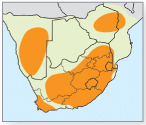

© L. DU PREEZ
A series of about 12 small and two large hooks posteriorly. Size: Up to 0.8mm in length. Biology: Ectoparasitic on carp (p.100), koi and goldfish and able to parasitise endemic redfin minnows (Pseudobarbus species) (pp.102–104). Introduced from Europe with carp hosts. Viviparous, producing live babies. RELATED SPECIES: G. kobayashi, with very similar characteristics to G. kherulensis, parasitises Prussian carp (Carassius gibelio).
3 Hippopotomus eye fluke
Oculotrema hippopotami


© L. DU PREEZ (BOTH)
Six suckers on a posterior extension of the body. Dark red when alive. Size: Up to 32mm in length. Biology: Ectoparasitic on the eyeballs of hippopotomi. Known from hippos (p.40, 1) in Uganda, Zimbabwe and South Africa, where up to 90% of individuals are parasitised.
Major parasites of vertebrates and molluscs, the life cycle always involving at least one vertebrate and one mollusc. Both sexual and asexual reproduction are involved, enormous numbers of asexually produced larvae being produced. Found in virtually all habitats, terrestrial and aquatic. Details of the life cycle are provided below for bilharzia flukes, because they are a significant public health risk in much of Africa.
4 Bilharzia fluke
Schistosoma haematobium


© OTIS ARCHIVE 1/CC BY 2.0

© J. DAY

© C. APPLETON
Adult worms long and thin, the female clasped permanently in a groove in the body of the male. Size: Adult male 10mm in length, female 15mm, miracidium <0.2mm, cercaria 0.25mm. Biology: Bilharzia (schistosomiasis) in humans is caused by the presence of adult flukes in the blood vessels of the bowel or bladder. S. haematobium (4 electron micrograph) lives in the bladder and causes urinary bilharzia. Unusually for flukes, the sexes are separate. Male and female flukes join in copulo and remain together in a blood vessel of the host’s urinary bladder for as long as they live (3–7 years). During her lifetime a female will lay tens of thousands of eggs (4a), each of which has a sharp tooth that ruptures the wall of the blood vessel, allowing the egg to escape into the bladder and be voided in the urine. If it reaches water the egg hatches to form a minute free-swimming larva called a miracidium (4b, stained specimen), which is attracted to the smell of certain freshwater snails such as Pfeiffer’s ramshorn snail (Biomphalaria pfeifferi) (p.130, 3). Boring through the flesh of the snail, the miracidium comes to rest in the snail’s liver and undergoes massive asexual reproduction, producing thousands and thousands of larvae called cercariae (4c shows bags, stained, of vegetatively dividing parasites). They, in turn, bore out of the snail’s body and swim freely in the water. If they encounter a human, they bore through the skin, metamorphose to the adult form, mate, and find their way to a suitable blood vessel to continue the life cycle. Except in the southwestern Cape, infected flukes are probably found in all wetlands, reservoirs and slow-flowing rivers where humans are likely to urinate. Contamination is easy to prevent by not urinating in freshwater systems, but this is not possible to regulate! RELATED SPECIES: S. mansoni causes intestinal schistosomiasis. The two species are hard to tell apart.
Worms with complex segmented bodies, found in fresh water and the sea, on land, and as external parasites. Earthworms and their allies (Oligochaeta) and leeches (Hirudinea) occur in fresh waters. Hermaphrodites. Sexual reproduction involves mutual exchange of sperm. New individuals resemble adults.
Elongate worms with a distinct head and bundles of bristles on each segment. Food consists of organic material, often contained in earth or sediments. Fertilised eggs protected in jelly-like cocoons. About 20 species of true earthworm are aquatic in southern Africa; several seem to be endemic to the continent. Most aquatic oligochaetes are tiny and strictly confined to aquatic ecosystems; about 50 species are known from southern Africa. Some require clean water but others are tolerant of gross organic pollution.
1 Aeolosoma worms
Family Aeolosomatidae


© NATURA MEDITTERANEA
Aeolosoma hemprichi is microscopic, transparent. Body with small spots and about 10 sets of setae (bristles). Head ciliated underneath. Size: Body up to 1mm in length. Biology: Reproduce by budding, forming chains of up to six individuals. Sexual reproduction rare. Abundant in ponds, streams and even sewage works.
2 Naidid worms
Family Naididae


© HEIDI

© J. DAY
Small delicate worms with fine bristles in sets down the body; usually <40 segments. May have a thin pointed proboscis (2, Pristina). Individuals often bud (2a), so if recently separated from a chain of individuals, no clear head or tail can be seen. Size: Usually <10mm. Biology: Very common but rarely seen, because they are tiny and because the body easily breaks up. Many species identifiable only with reference to the bristles viewed under high power. Thirteen genera and about 40 species recorded from southern Africa; many still to be described.
3 Sewage worm
Tubifex tubifex


© C. GRIFFITHS

© MATTHIAS TILLY/CC BY SA 3.0
Long thin worms (3), often red in colour (caused by the presence in the body of haemoglobin, which allows extraction of oxygen) and living in a mucous tube. Size: Body up to 30mm in length. Biology: When alive, head buried in the organic sediment and ‘tail’ wafting in the water (3a), creating a current. May occur in countless millions in highly organically polluted sediments. Cosmopolitan. RELATED SPECIES: Ten genera and 17 species of Tubificidae are known from southern Africa. Most are not associated with polluted waters.
Worms with a sucker at each end; relatively short and stout when dead, but body can extend considerably when alive. Segmented and annulated, each segment often consisting of a number of circular ‘wrinkles’ or annuli. Not all leeches are bloodsuckers: many of the smaller forms are carnivorous, feeding on small invertebrates.
4 Marsupial leech
Marsupiobdella africana


© C. GRIFFITHS
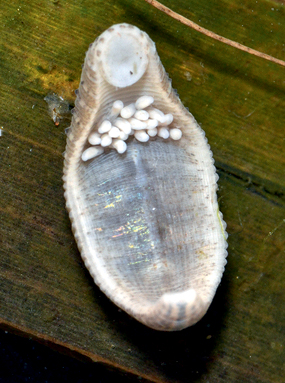
© C. GRIFFITHS
Small pale leech that broods its young in brood pouch (4a) on ventral surface; one pair of eyes coalesced into a central mass. Size: Up to 12mm in length. Biology: Ectoparasitic, apparently only on platannas (Xenopus species) (p.74) – and therefore an African endemic. Uses river crabs (p.244) for protection and transport. The only species in its genus.
5 Common African leech
Aliolimnatis michaelseni


© C. GRIFFITHS
Dark brown with faint longitudinal stripes. Five pairs of eyes arranged in an arch. Jaws present. Size: 60–90mm in length when extended. Biology: Very common throughout the region, feeding on blood of mammals, amphibians and fishes. Young leeches also feed on snails. RELATED SPECIES: Three other species of Aliolimnatis, distinguishable by colour patterns. Closely related to medicinal leeches.
6 Helobdellid leeches
Helobdella species


© C. GRIFFITHS
Slender; pale background with dark, double, mid-dorsal stripe and a pair of dark lateral spots on each segment. Size: 14mm in length. Biology: Not a bloodsucker; feeds on small invertebrates. The species illustrated here may be the same as Helobdella europea, a European leech that is invasive in New Zealand.